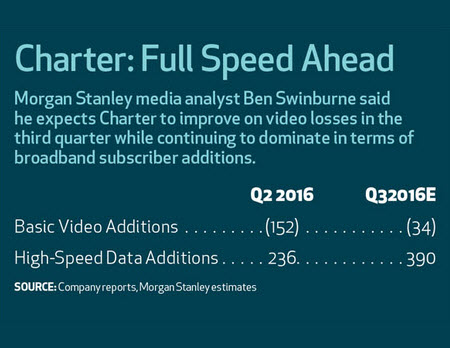Cable Extends Its Reign Into Q3

Cable operators appear poised for a strong third quarter on the heels of Comcast’s stronger-than-expected results, with satellite TV continuing to slide.
Comcast outpaced most analysts’ expectations by adding 32,000 basic video subscribers in the third quarter — its best Q3 showing in a decade and well above consensus estimates of about 1,000 customer additions.
The performance helped to solidify what many analysts who follow the sector have been saying for a while: Cable is king, for now.
Comcast’s performance in light of a declining overall pay TV customer base shows cable is taking back market share. According to MoffettNathanson principal and senior analyst Craig Moffett, that performance was largely driven by the success of its X1 platform — now available in 45% of its footprint — and continued strength in broadband. Comcast added 330,000 broadband customers in the third quarter, its best Q3 performance in eight years.
CHARTER, ALTICE ON DECK
While other operators aren’t expected to fare quite as well, they are expected to show improvement on both the video and broadband front.
Charter Communications and Altice USA, parent of the former Cablevision Systems and Suddenlink Communications, are expected to release their Q3 results on Nov. 3 and Nov. 10, respectively, the latter as part of Altice N.V.
The smarter way to stay on top of the multichannel video marketplace. Sign up below.
Analysts generally expect marginal video-subscriber losses for Charter — ranging from about 20,000 to 30,000 customers — but with momentum building later in the year.
The same holds true for Altice USA. Pivotal Research Group CEO and senior media & communications analyst Jeff Wlodarczak expects strong cash-flow growth from the U.S. cable unit, fueled by cost efficiencies, a $5-per-month price hike for data service at Suddenlink and continued cost-cutting by the Optimum (formerly Cablevision) operations.
Wlodarczak estimated that revenue-generating units, a combination of voice, data and video customers, will decline by 25,000 for Suddenlink and by about 30,000 for Optimum.
At Charter, Morgan Stanley media analyst Ben Swinburne expects more churn as customers roll off of legacy TWC promotional pricing, leading to a loss of about 34,000 video customers in Q3.
Charter will add about 390,000 broadband customers in the quarter, well above the prior period gain of 236,000 subscribers.
Charter continues to integrate Time Warner Cable and Bright House Networks operations — the deal closed in May — and Swinburne believes that after a slight early hiccup, a strong growth trajectory should continue. “We continue to believe Charter shares offer investors a rare levered equity growth story, particularly given the visibility into that growth and capital allocation for a company of its size,” he wrote.
Swinburne said recent results — in the second quarter, video losses improved to 152,000 from 170,000 in the year-earlier period, and revenue and cash flow grew by 6.6% and 9%, respectively — reaffirms his view that Charter “can successfully implement the strategy it has proven out over the last four years on its now-larger footprint.”
Overall, cable should have a good quarter on the subscriber front. Swinburne estimated that MSOs should collectively lose about 20,000 video subscribers, amended from the 52,000 he predicted earlier when he believed Comcast would lose 8,000 customers in Q3.
If cable is to be the king for the period, though, Telsey Advisory Group media analyst Tom Eagan pegs Dish Network as a pauper.
DOWN ON DISH NETWORK
Dish is coming off a string of subscriber losses — it shed 28,000 in the first quarter and 281,000 in Q2 — and the third quarter is expected to be no different. Eagan expects Dish to shed about 125,000 customers in the third quarter, ending the period with 13.3 million subscribers.
“Dish’s business model is proving increasingly unsustainable,” Eagan wrote in a research note. While cash flow will likely increase 20% for the year, that is due more to easy comparisons with 2015. Even Sling TV, which is expected to end the year with about 700,000 customers, according to Eagan and has been the main focus of the company, could be impacted by AT&T’s over-the-top offering, DirecTV Now. AT&T said it plans to launch DirecTV Now in November at $35 per month for more than 100 channels. Sling TV sells at $20 per month for more than 25 channels.
Swinburne was equally down on Dish’s prospects — he predicted it would lose about 155,000 subscribers in Q3 and estimated it would shed between 650,000 and 660,000 subscribers per year through 2019, partially offset by average annual gains of 240,000 to 245,000 customers for Sling TV.
“We expect these trends to continue over the medium-term, particularly given cable’s investment in its product and the likely launch of new offerings in 4Q16 (DirecTV Now) and 1H17 (Hulu),” Swinburne wrote.
